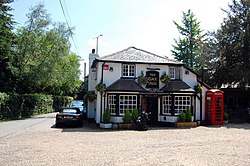Bank, Hampshire
| Bank | |
| Hampshire | |
|---|---|
 The Oak Inn, Bank | |
| Location | |
| Grid reference: | SU286071 |
| Location: | 50°51’42"N, 1°35’43"W |
| Data | |
| Post town: | Lyndhurst |
| Postcode: | SO43 |
| Dialling code: | 023 |
| Local Government | |
| Council: | New Forest |
| Parliamentary constituency: |
New Forest East |
Bank is a hamlet in south-western Hampshire, barely a mile south-west of Lyndhurst in the New Forest and some eight miles from each of Ringwood and Southampton. It has one inn and approximately 30 distinct dwellings.
The village sits to the south of the main A35 road through the New Forest, bounded by woodland or wood pasture except on the east where there are arable lands, and former parkland of the Cuffnells Estate. The hamlet is an eclectic mix of former workers' cottages together with higher status buildings constructed by 19th century cultured owners seeking country retreats. It has no community facilities, other than the Oak Inn.
History
The village of Bank seems to begin in the 16th century, as a settlement encroaching on the Forest.[1] The original name was apparently "Annis' Bank".[1]
The oldest surviving building today is Japonica Cottage, which dates from the 16th century. Old Cottage dates from the 17th century, although it is nowadays dominated by a 20th-century wing.
To the east of Bank were the large 18th-century estates of Cuffnells and Wilverley, and the inhabitants of Bank may have been involved in servicing these two large estates and their associated farms. The Oak Inn is a two-storey late 18th century building of painted brick, which may have been a cider house in the 18th century.[2]
Nearby is a small cluster of cottages which go by the name of Gritnam. It is likely that Gritnam is the place recorded in the Domesday Book of 1086 under the name "Greteha".[3] An alternative suggestion is that "Greteha" is the hamlet of Swan Green just west of Lyndhurst It was one of the 51 manors held by Waleran the Hunter as recorded in the Domesday Book of 1086.[3] Prior to 1066, Bolla had possessed it from King Edward.[3] Gritnam is also mentioned in 1300 as "Grettenhamdune" (i.e. Gritnam down).[4] The name might mean "the gravelly place,"[4] or "the great homestead."
The famous New Forest "snakecatcher" Brusher Mills was reported living in an old charcoal burner's hut by the boundary of nearby Gritnam Wood in around 1895.[5]
The Liberal MP, Robert John Price, was a resident of Bank,[6] as was the Liberal M.P. John Fletcher Moulton,[7] who, when he entered the House of Lords in 1912, took the title "Baron Moulton of Bank".[8]
Literary connections
Several literary figures have stayed in Bank. Mary Elizabeth Braddon, author of the sensation novel, Lady Audley's Secret, built Annesley House, with her husband, in the 1880s.[8] They used it as a country home, whilst retaining a main residence in Richmond in Surrey.[8] Her son, the novelist W. B. Maxwell, also stayed here as a young man.[9] The house was later used as a Barnardo's children's home.[8]
In Christmas and New Year, 1904–05, Virginia Woolf stayed at Lane End House in Bank with her sister and two brothers.[10] Later, Rupert Brooke stayed at a cottage called "Beech Shade" in Gritnam.[11] He would later write to his friend, Bryn Olivier, about his recovery from depression in Bank:
Then there was Bank, Bryn. For three whole months I'd been infinitely wretched & ill, wretcheder than I'd thought possible. And then for a few days it all dropped completely away, and — oh! how lovely Bank was! — I suppose I should never be able to make you see what beauty is to me, — physical beauty — , just even the seeing it in spite of all the hungers that come.[12]
Outside links
| ("Wikimedia Commons" has material about Bank, Hampshire) |
- Bank and Gritnam – what’s in a name?, New Forest Explorer's Guide
- Bank and Gritnam – historic families; historic buildings, New Forest Explorer's Guide
- Annesley, Miss Braddon and the History of Bank, New Forest Explorer's Guide
References
- ↑ 1.0 1.1 Bank and Gritnam – what’s in a name?, New Forest Explorer's Guide, retrieved 11 July 2011
- ↑ Ant Veal's Top UK Pubs – The Oak Inn, Bank, Lyndhurst
- ↑ 3.0 3.1 3.2 Bank, Hampshire in the Domesday Book
- ↑ 4.0 4.1 Gritnam, Lyndhurst, Old Hampshire Gazetteer
- ↑ G. E. Mingay, (1998), Rural life in Victorian England, page 134. Sutton
- ↑ Royal blue book: Fashionable directory and parliamentary guide, (1900), page 1185. London (England)
- ↑ 'Dod's parliamentary companion', page 93
- ↑ 8.0 8.1 8.2 8.3 Annesley, Miss Braddon and the History of Bank, New Forest Explorer's Guide, retrieved 11 July 2011
- ↑ Stanley Kunitz, Howard Haycraft, (editors), (1985), "MAXWELL, WILLIAM BABINGTON" entry in Twentieth Century Authors: A Biographical Dictionary of Modern Literature: Volume 2, page 940
- ↑ Virginia Woolf, (1994), The Essays of Virginia Woolf: 1904 to 1912: Volume 1, page 53. Hogarth Press
- ↑ Mike Read, (1997), Forever England: the life of Rupert Brooke, page 67. Mainstream
- ↑ Nigel Jones, (2003), Rupert Brooke: life, death & myth, page 291. BBC Worldwide